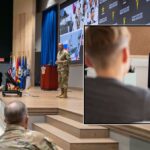
UPDATED: 1450/15 Dec 2020
A BETTER PEACE welcomes Robert Payne to discuss the radicalization of U.S. military members, particularly in the Army. Payne joins podcast editor Ron Granieri in the virtual studio to examine how individual members of the Army are radicalized and what the service and law enforcement need to do to defeat the problem. Their conversation covers how extremism finds its way into the ranks and how this isn’t a new phenomena.
EDITOR’S NOTE – At approximately 12:15 in the discussion a crucial data point was omitted seemingly creating a math error when COL Payne cites “15% of an extremist database having military service.” To clarify the numbers we’ve included the original source data from COL Payne’s research below.
The database contained 2,148 extremists who had radicalized to violent and non-violent extremism in the United States from 1948 to 2017, coded by ideology. PIRUS noted 922 far-right extremists have made up the most extensive ideological base with 496 Islamist extremists prevalent after the September 11, 2001 attacks.36 The PIRUS research found 230 (15.8 percent) of 1,456 extremists possessed military experience in the database, while 192 (18.9 percent) were connected to DT ideologies and thirty-eight (8.7 percent) to Islamist ideology.37 The PIRUS researcher noted 692 (32.2 percent) of the 2,148 extremists in the database could not be verified as having military service or not having military service based on open source research and public records. Therefore, the primary researcher offered the number of extremists in the PIRUS project with military service would likely be higher with some uncertainty of the actual percentage.
The statistical population of the U.S military that have become terrorists is very small but of the U.S terrorist population…within the US population, there is a higher statistical number that have served in the U.S. military
Podcast: Download
Robert Payne is a colonel and was commissioned as a Medical Services Corps Officer in the U.S. Army. Having served 5 years active duty he has spent the last 16 years in the U.S. Army Reserve. His current reserve assignment is as a Research Fellow assigned to the Center for Strategic Leadership. In his civilian profession, he is an FBI Supervisory Special Agent (SSA) with background in narcotics, counterterrorism ( 3 x JTTFs), organized crime, HUMINT operations, and most recently, Healthcare Fraud. Ron Granieri is an Associate Professor of History at the U.S. Army War College and the Editor of A BETTER PEACE. The views expressed in this presentation are those of the speakers and do not necessarily reflect those of the U.S. Army War College, U.S. Army, or Department of Defense.
Photo Description: The Alfred P. Murrah Building after the bombing and just shortly before the May 23, 1995 demolition of the building. The building was damaged by a domestic terrorist truck bombing perpetrated by Timothy McVeigh and Terry Nichols at 0902 on 19 April 1995. McVeigh served 13 years in the Army while Nichols only served 10 months. They met during basic training. The blast killed 168 people, many of them children in the building’s day care, and injured more than 680 more. The blast destroyed or damaged 324 other buildings within a 16-block radius, shattered glass in 258 nearby buildings, and destroyed or burned 86 cars. Inset is the Alfred P. Murrah Building in 1977.
Photo Credit:Photographer unknown, courtesy of the Social Security Administration





The first thing that I would consider acknowledging here is the possibility that — whether we are talking about active and/or former soldiers who join radical Islamic groups — and/or talking about active and/or former soldiers who join radical Right groups — the fundamental “cause” of the soldiers joining either of these such groups might be the same; this being, to oppose certain unwanted political, economic, social and/or value “change” policies that their government has either:
a. Already imposed on the populations (those abroad and/or those here at home) and/or
b. Seeks to impose on the populations (same criteria).
(In this regard, I suggest that we consider whether the Islamist’s disagreement with such things as government-imposed “girls schools;” whether this should be seen in the same light as the Rights disagreement with such things as government-imposed “Roe v. Wade.”)
As to this such contention, consider the following excerpt from the bottom of Page 5 of the Army War College transcript of this podcast — provided at this link:
https://warroom2.armywarcollege.edu/wp-content/uploads/20-190-HIDING-IN-PLAIN-SIGHT-RADICALS-IN-THE-RANKS-Transcript.pdf
“So whether they’re in the military or they’re about to leave the military, the military in its mission to conduct combat is asking us to do that on behalf of an ideology, a belief in our nation. But when they can’t rationalize that for some reason, or they become disillusioned, it just creates this environment for radicalization and that’s what ties the military. And the heightened concern is the fact that we have training and weapons, combat experience, communications, things that would make it more concerning and especially from my perspective as an investigator.”
Bottom Line Thought — Based on the Above:
If — after being in the military for some time — the individual soldier decides that the domestic and/or foreign policies of their nation run counter to his or her own beliefs — and yet, being in the military, the individual soldier is required to deal with, sometimes lethally, those individuals and groups both at home and/or abroad who would stand against such policies — then this puts the individual soldier in something of a difficult position indeed.
And, if the soldier — thus disillusioned — then decides to leave the military and join a radical group, then, as noted by our contributor above, his or her training and experience can cause him or her to:
a. Have significant immediate status in such an organization and
b. Be significantly valuable to same (and, thus, be significantly dangerous to us).
(Note: As an example of such potential for “radicalization” as I describe above — but admittedly not relating to soldiers or former soldiers — consider the following re: Afghan resistance to the policies imposed by Soviet/communist governments in Afghanistan in the 1980s:
“The overt attack on Afghan social values was presented, by the resistance forces, as an attack on Islamic values. This was also seen as an attack on the honor of women. The initiatives introduced by PDPA [the communist Peoples Democratic Party of Afghanistan] — to impose literacy on women and girls — inevitably raised questions as to the potential role of women outside the home. This provoked defensive actions from men, concerned with protecting the honor of women with their families, and to also ensure that traditional roles of women within the domestic sphere continued to be performed. It also generated fears that the important roles of women, as the primary vehicles for passing traditional and Islamic values from one generation to another, would be undermined if they were exposed to external and, particularly, non-Islamic values. This enabled the exiled radical Islamic parties to claim leadership of the resistance and to also declare a jihad.”
[Item in brackets above is mine.]
See the book “Afghanistan: Aid, Armies & Empires” by Peter Marsden, Page 58, in Chapter 4 entitled “The Soviet Military Intervention.”)
A follow-up to my initial comment above:
If the first task here — as I suggested above — was to acknowledge the possibility that the “cause” of active or former military personnel joining radical Islamist groups, and joining radical Right groups, may be the same; this such common cause being: to oppose certain unwanted (shall we call these “modern” or “progressive”?) political, economic, social and/or value “change” policies of their governments have either (a) already imposed or (b) are now trying to impose,
Then the next two (logical?) tasks, it would seem, would be to determine:
a. What might be the common “identity characteristics” of these two groups, i.e., their common “nature.” And, thereafter, to determine:
b. Whether these such “identity characteristics” make these two groups, more or less, a perfect “fit” — for use and exploitation by our foreign adversaries. (Adversaries who, indeed, may actually have designed their grand strategies around the use and exploitation of individuals and groups with these exact such “identity characteristics.” (In this regard, see the “containment” discussions below.)
As to my question “a” above, the answer here would seem to be that the common “identity characteristics” of both the radical Islamists groups, and the radical Right groups, is that they identify, radically, with what we might call “conservative” or “traditional” ideas, principals, beliefs and causes. (And, thus, they tend to, radically, oppose the political, economic, social and/or value changes that their governments have decided they must be make — for example — so as to remain competitive.)
As to my question “b” above, the answer here may best determined by looking at the “containment” grand strategy of one of our adversaries, in this case, Russia:
“In his annual appeal to the Federal Assembly in December 2013, Putin formulated this ‘independent path’ ideology by contrasting Russia’s ‘traditional values’ with the liberal values of the West. He said: ‘We know that there are more and more people in the world who support our position on defending traditional values that have made up the spiritual and moral foundation of civilization in every nation for thousands of years: the values of traditional families, real human life, including religious life, not just material existence but also spirituality, the values of humanism and global diversity.’ He proclaimed that Russia would defend and advance these traditional values in order to ‘prevent movement backward and downward, into chaotic darkness and a return to a primitive state.’
In Putin’s view, the fight over values is not far removed from geopolitical competition. ‘[Liberals] cannot simply dictate anything to anyone just like they have been attempting to do over the recent decades,’ he said in an interview with the Financial Times in 2019. ‘There is also the so-called liberal idea, which has outlived its purpose. Our Western partners have admitted that some elements of the liberal idea, such as multiculturalism, are no longer tenable,’ he added. …
(See the Wilson Center publication “Kennan Cable No. 53” and, therein, the article “Russia’s Traditional Values and Domestic Violence,” by Olimpiada Usanova, dated 1 June 2020.)
Bottom Line Thought — Based on the Above:
In the Old Cold War of yesterday (and as a fundamental and basic component of our “containment” grand strategy vis-a-vis the Soviets/the communists back then?), the U.S./the West — both at home and abroad — made exceptional use of individuals and groups with “identity characteristics” of “conservative” or “traditional.” (After all, identity characteristics of “conservative” or “traditional” are a perfect “fit” — this, when one seeking to prevent a type of unwanted “progress” or “modernization.” Yes?)
Now, in today’s New/Reverse Cold War, it would appear that our opponents (not only Russia but also the Islamists, etc.?) have decided to (a) return this “containment” favor and, this, by (b) specifically using these exact same “conservative”/”traditional” assets now against us.
(No need to “reinvent the wheel” here; this, if one’s opponent, for example the U.S./the West, has now decided [or, indeed, been forced] to move forward in the direction of “progress” and “further modernization” themselves and, thus, have now had to expose themselves — both at home and abroad — to [a] multiple and various “containment” grand strategies and, accordingly, to [b] the exceptional availability and use of individuals and groups with “conservative” and “traditional” “identity characteristics” therein. [“Turnabout,” after all, being “fair play?])
Hi,
I am doctoral student beginning my third year of a criminal justice (focused in Homeland Security) program as well as an active duty service member.
I am fine tuning my dissertation topic which is extremist ideology is a form domestic terrorism and I also came across the testimony to the House of Representatives Armed Services Committee Military Personnel Subcommittee regarding extremists in the military and the subject intrigued me enough to potentially pursue it as my dissertation topic.
I would like to get in contact with COL Payne regarding ‘radicals in the ranks’ and moving forward to study this topic.
Thank you.
Very respectfully,
Ms. Peters
As an AWC graduate I listened to this Podcast and found it light on facts and long on generalities and references to civilian studies concerning “Extremism” in the force. A civilian listening to it would come away with the feeling that the Army has a problem with extremism, which it does not.
A good starting point would be to get some facts not opinions nor assumptions on the table. For example, how many soldiers have been discharged from the Army for being extremists? Other services? Citing a Timmothy McVeigh and an Islamist radical at Fort Hood does not translate to the entire force. Let’s stop projecting this false notion on the 99.99% of the Army that serves with valor and distinction every day.
A Podcast without some context such as the number of citizens who have served over the past 15 years (a big number) compared with the number who have been discharged due to extremism might be a useful place to start. While we are at it, maybe naming the top 10 extremist organizations you are all talking about would be another data point worth knowing. I would take the FBI list to start.
If the SECDEF is demanding a service wide stand down the problem must be significant. I simply don’t see it from my foxhole.
Can we expect to see a follow-up Podcast with more factual details.